Northern Channel Island Wreck Information
The Channel Islands are very diverse and large with quite a few wrecks. Because of this, we have made two separate pages covering the wrecks in the Channel Islands. This one has the wrecks in the four Northern Channel Islands and the other page has the wrecks in the four Southern Islands. We have tried to cover as much of the history and details of each wreck that we could. Some of the wreck diving sites you will find on maps and others you won’t. Over the years, Ken the owner of Channel Islands Dive Adventures has dived all these wrecks.
We hope you enjoy all the information listed here and come back to read a little each time. There is just way too much to check out at one time.
Kopco Star
Gruman Guardian
TBM Avenger
Spirit of America
SM-1 Humble
Gosford
Ventura County Wrecks
To learn more about Southern California wrecks & wreck diving, please visit the California Wreck Divers (CWD) website along with another excellent resource, the book “Shipwrecks of Southern California” by Bonnie J. Cardone and Patrick Smith. The book is no longer in print but maybe still available through Amazon.
Ventura County Coastal Wrecks
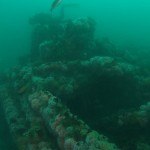 The wrecks we visit are mainly 50’-60’ fishing boats, 30’-40’ sailboats, and some other assorted ones along with the La Jannelle pieces. The wrecks we visit are not known or dove by many and there is not much known about most of the wrecks we visit. Most are offshore, in the sand, and are hulls with debris around them with no penetration. We are always looking for more, depths range from 50’-100’ and visibility can be 10’-40’. Experienced divers with good buoyancy skills, possible currents, and surface signal device recommended.
The wrecks we visit are mainly 50’-60’ fishing boats, 30’-40’ sailboats, and some other assorted ones along with the La Jannelle pieces. The wrecks we visit are not known or dove by many and there is not much known about most of the wrecks we visit. Most are offshore, in the sand, and are hulls with debris around them with no penetration. We are always looking for more, depths range from 50’-100’ and visibility can be 10’-40’. Experienced divers with good buoyancy skills, possible currents, and surface signal device recommended.
Kopco Star
The KopcoStar was built at Terminal Island (San Pedro) in 1952 and measured 51.6’ long, 27.3 in the beam, 4.8 in-depth, and powered by 4 diesel engines with a rating of 900hp. It was owned by the Kopco Star Co. of Los Angeles and was a kelpcutter that operated out of the Kopco kelp processing facility in Pt. Hueneme (Ventura County) harvesting kelp from Pt. Hueneme to Pt. Conception.
 Kelp harvesting was a very important commercial industry with the harvesting of kelp along much of the California coast. Harvesting was permitted under leases granted by the State Fish and Game Commission, with regulations established by the Commission. The type of kelp Kopco harvested was the Giant Brown Algae to be used mainly in stock and fertilizer.
Kelp harvesting was a very important commercial industry with the harvesting of kelp along much of the California coast. Harvesting was permitted under leases granted by the State Fish and Game Commission, with regulations established by the Commission. The type of kelp Kopco harvested was the Giant Brown Algae to be used mainly in stock and fertilizer.
With only the top four feet allowed to be harvested, the Kopco Star would leave at midnight to be at her destination when the tides were the best until one night in question on October 1, 1963, at around 10:00 pm when she listed to port shortly after taking on a heavy load of kelp and sunk about 6 miles offshore from Pt. Hueneme. There was almost no warning, preventing the crew from making a radio call for help.
The uninjured captain and engineer were rescued by chance by a Navy tugboat about 1 ½ hours after the Kopco Star sunk. Given the circumstances of the Kopco Star sinking at night and not being able to make a call for help, they were very lucky to be rescued so quickly before their ordeal turned into a disaster.
Read more about the Kopco Star and the newspaper article on her sinking.
Diving the Kopco Star
Diving the Kopco Star can be an awesome dive and requires a little dive planning to get the most out of the trip. The best time to dive the Kopco Star is at slack tide in the fall on a day with the least tidal change.
The Kopco Star sits on a sandy bottom in a westerly direction at a depth of 85’ with an average visibility of about 10’-20’. Measuring about 25 x 60, it is a very picturesque dive. The bow area is where the kelp would have come up and over into the ship and it stands about 10’ high and is home to many fish and scallops. The stern is home to 4 diesel engines and props, an adult wolf eel, and more fish; it stands about 6’-8’ high. There is a slight list to port with the starboard side about 3’-4’ high.
There is no place big enough to penetrate the wreck, but there are many small areas to poke your head into and look into the wreck. The Kopco Star has become its own artificial reef with a large assortment of fish and invertebrates such as sheep head, sand bass, Cabazon, schooling blacksmith’s, lobster, and much more. While diving the Kopco Star don’t forget to watch overhead because there are usually schools of fish and sometimes the occasional jellyfish passing through. This also one dive you can see a wolf eel or two in Southern California.
At 85’ deep, the Kopco Star is an excellent dive for nitrox and you can see the entire wreck in one dive. When you dive the wreck, it is suggested to start at one end and dive the perimeter then check out the center area, making sure you take plenty of time to look around the bow with its rigging and fish hiding in and around it. Also, take plenty of time to check out the stern with the wolf eel (he sticks his head out of a hole in the top center) and the engine area with its 4 props at the sand level.
Afterward, it will probably be time to make your ascent to the boat and talk about how cool the Kopco Star was to dive. Please remember to take nothing except photos, videos, and memories and leave nothing but bubbles.
*One very interesting note is the Kopco Star was used in the Sea Hunt episode “Magnetic Mine”-now how cool is that!
The Kelpcutter video-courtesy of Kevin & Liz Sullivan
Kopco Star video-courtesy of Bruce Carnall
Guardian Plane Wreck, Santa Cruz
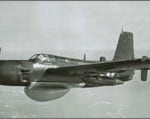 The Guardian is a WWII Navy Grumman Guardian AF-2W. This plane was on a mission in March of 1954 searching for a missing jet. It had engine trouble and was ditched in the water with no problems. It is outside of a harbor near Gull Island,
The Guardian is a WWII Navy Grumman Guardian AF-2W. This plane was on a mission in March of 1954 searching for a missing jet. It had engine trouble and was ditched in the water with no problems. It is outside of a harbor near Gull Island, 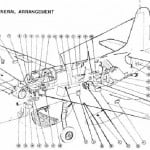 Santa Cruz Island at a depth of 50’-60’. The plane sits upright on a sandy bottom and has become an artificial reef with kelp and fish around it and the visibility is from 10’-30’. This can be a very fun dive if the weather is on our side.
Santa Cruz Island at a depth of 50’-60’. The plane sits upright on a sandy bottom and has become an artificial reef with kelp and fish around it and the visibility is from 10’-30’. This can be a very fun dive if the weather is on our side.
To read more about the Grumman Guardian and learn more about wreck diving, please visit the California Wreck Divers (CWD) website.
Anacapa, TBM Avenger Plane Wreck
 The Avenger is a WWII Navy torpedo bomber that was on a training mission in the early ’50s along with 4 other planes. It hit another plane in the formation and they both crashed. The one that we dive went down on the front side of east
The Avenger is a WWII Navy torpedo bomber that was on a training mission in the early ’50s along with 4 other planes. It hit another plane in the formation and they both crashed. The one that we dive went down on the front side of east 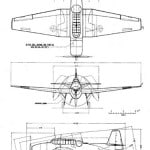 Anacapa and had no loss of life. The other plane went down on the backside of Anacapa with loss of life and has never been found. The TBM sits in about 120’ in the sand about 40’ from a nice reef and can have visibility of 20’-60’. After all the years you can still tell it’s a plane. It has attracted fish around it and is an excellent deep dive.
Anacapa and had no loss of life. The other plane went down on the backside of Anacapa with loss of life and has never been found. The TBM sits in about 120’ in the sand about 40’ from a nice reef and can have visibility of 20’-60’. After all the years you can still tell it’s a plane. It has attracted fish around it and is an excellent deep dive.
TBM Avenger video-courtesy of The Hirsche’s
Avenger-then & now video-Courtesy of Ken Kollwitz
The Spirit of America (formerly identified as the Peacock), Northeast Santa Cruz Island
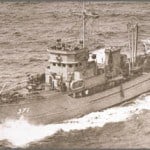 The Spirit of America (if that is what her real name is) had a lot of mystery around her. It was known that the wreck was a WWII Minesweeper that sunk in the ’70s. The Spirit of America sits upright on a sandy bottom at about 65’deep outside the
The Spirit of America (if that is what her real name is) had a lot of mystery around her. It was known that the wreck was a WWII Minesweeper that sunk in the ’70s. The Spirit of America sits upright on a sandy bottom at about 65’deep outside the  Scorpion Anchorage, Santa Cruz Island. Visibility here can be 15’-40’. With the hull and its structure to explore the Spirit of America is a very good dive. It is in a protected area and there are lots of fish and the biggest Spanish Shawls on her.
Scorpion Anchorage, Santa Cruz Island. Visibility here can be 15’-40’. With the hull and its structure to explore the Spirit of America is a very good dive. It is in a protected area and there are lots of fish and the biggest Spanish Shawls on her.
To read more about the Spirit of America and learn more about wreck diving, please visit the California Wreck Divers (CWD) website.
Below is from my friend Jonathan Hanks who has since passed away so the mystery will probably never be researched much again on this wreck but it goes to show how much work goes into identifying something like a wreck.
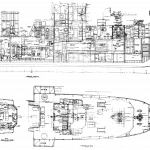 There’s no mystery about how the Spirit of America ended up at Scorpion Anchorage. What is VERY mysterious is just what ship the Spirit of America really is. The LA Times reported on December 13th, 1978 that a vessel named “Spirit of America” had been badly damaged in a fire at Wilmington.
There’s no mystery about how the Spirit of America ended up at Scorpion Anchorage. What is VERY mysterious is just what ship the Spirit of America really is. The LA Times reported on December 13th, 1978 that a vessel named “Spirit of America” had been badly damaged in a fire at Wilmington.
The burned hulk ended up in the possession of Al Kidman, the infamous salvage “king” of San Pedro. He was using Santa Cruz Island as a place to go about his work, away from harbor authorities. The Spirit of America is just one of three former minesweepers that Kidman towed to Santa Cruz for salvaging. The other two were ex USS Reaper and USS Prime. Prime was beached and burned at Scorpion Anchorage so that the nonferrous metals could be scavenged, while Reaper was beached and burned at Smugglers for the same reason.
The Spirit of America avoided this fate by sinking at anchor unexpectedly. So far, we’ve established that a vessel is known as “Spirit of America” burned, that it was towed to Scorpion’s for salvaging and that it must have been a former minesweeper due to the wreck’s hull layout and distinctive bar stool shaped gun mount at the bow. Now the question is what is the identity and history of the “Spirit of America?”
A careful review of the records shows that there was something very suspicious going on, which is consistent with the story that the vessel was a floating bordello or shady venue of some sort. A vessel as large as the Spirit of America has to be registered, but despite extensive searching, I could find no entry for a “Spirit of America” in any MVUS volume going all the way back to the mid-1940s. This is highly suspicious, to say the least. There is no solid, material evidence linking the Spirit of America to the names Hornbill, YMS-371, or Peacock, there is however a lot of circumstantial evidence making it highly plausible that the Spirit may actually be that ship.
The sequence of available records goes like this:
- 1943- Minesweeper YMS-371 launched
- 1947- Renamed USS Hornbill (AMS-19)
- 1955- Reclassified as MSC(O)-19
- 1957- Decommissioned
- 1960- Sold
1962- Vessel appears in MVUS as the towing vessel *Los Buscaderos, with official number 284129. The asterisk indicates a recent name change, listed in the back of the volume. The former name given for this vessel is USS Hornbill. Homeport listed as Corpus Christi, Texas.
1964- Vessel listed with name *Peacock. The official number and former name listing of Hornbill and Los Buscaderos confirms we’re still talking about the same ship. The vessel has changed owners and is now operating as a towing vessel out of San Juan, Puerto Rico. The owner given is San Juan Towing and Salvage Corp.
1976- Vessel still listed in MVUS as Peacock. Same owner and home port as ’65 entry. - 1978- Vessel still listed as owned by San Juan Towing and Salvage Corp.
December 1978 – Newspapers report that a 136′ vessel called “Spirit of America” burned at Berth 200B in Wilmington. No record of a vessel with that name appears anywhere in any MVUS volume in the last 40 years. - 1979- Peacock, #284129 listed in the “vessels lost” section of MVUS volume. No date is given, only the year 1969. The cause of loss is “Reported seized by Dominican Republic Government.” The place of loss listed is “Unknown.”
With all that in mind, let’s do a little theorizing. Here is what I believe is the story: YMS-371/Hornbill/MSC(O)-19 serves in the USN until being decommissioned in 1957. By 1962 she has been bought up by a private owner and enters into the official record, as Los Buscaderos, #284129.
In 1963 a new owner, the San Juan Towing and Salvage Corp. buys her and renames her as Peacock. The Peacock is the only documented vessel the corporation owned, and the corporation only appears in the MVUS owner/operator list after buying the Peacock in 1963 and disappears from MVUS the same year that the Peacock is reported lost, 1979. I speculate that San Juan Towing and Salvage may have been a non-existent front company for her actual owners, but in any case, I’m not convinced the vessel was ever actually in Puerto Rico.
I believe that it’s around this time (mid-1960’s) that the vessel is actually brought to the west coast. For the next 15 years, she keeps a low profile, maybe already under the alias “Spirit of America” or another name. In 1978 a fire, possibly intentional (Newspaper reports indicate an investigation) guts the vessel, which is then towed off to Santa Cruz Island for salvage and disposal. The owners then falsely report the “Peacock,” her registered name, as having been seized by the Dominican Republic some ten years earlier to get it off the records and out of documentation.
The last thing needed was for Jonathan to pay a visit to the national archives in Perris, CA and see about tracking down a copy of the loss report from 1979. That will not happen as he passed away in February 2018. May you rest in Peace Jonathan!
Santa Barbara County Wrecks
North Santa Barbara/Gaviota Coastline Humble SM-1
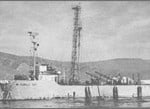 The SM-1 was originally a U.S. Navy Medium Landing Ship (LSM-251) near the end of World War II. It was originally
The SM-1 was originally a U.S. Navy Medium Landing Ship (LSM-251) near the end of World War II. It was originally 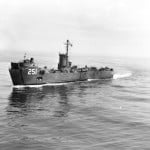 204’ ft long and was driven by twin diesel. At the end of the war, it was sold to Western Oil and Refining Co.
204’ ft long and was driven by twin diesel. At the end of the war, it was sold to Western Oil and Refining Co.
It was renamed the Humble SM-1 in 1958 and made into an oil drilling barge with several modifications. The SM-1 worked offshore between Ventura and Point Conception. She now was a barge and towed to the drilling sites. In 1962 there was a big squall, creating large seas. The large seas caused the SM-1 to drag anchor (6 of them were used) and eventually she capsized, sinking in 75’ of water.
She was then salvaged and is now a great dive site. The SM-1 now lies upside down about 2-3 miles 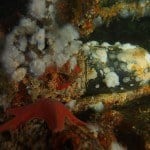 offshore between Gavotia and Coho Anchorage. The SM-1 is an advanced dive and can be penetrated, but only by divers with proper training. The SM-1 has kelp and schools of fish along with some great wreckage to look at. You MUST be careful diving the SM-1 as there are lots of jagged metal and other hazards such
offshore between Gavotia and Coho Anchorage. The SM-1 is an advanced dive and can be penetrated, but only by divers with proper training. The SM-1 has kelp and schools of fish along with some great wreckage to look at. You MUST be careful diving the SM-1 as there are lots of jagged metal and other hazards such 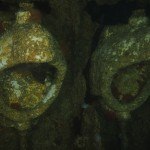 as current and the lure of seeing what is inside. There are plenty of holes to see inside and there is a large debris field on the starboard side.
as current and the lure of seeing what is inside. There are plenty of holes to see inside and there is a large debris field on the starboard side.
The SM-1 can be great for pictures and just plain sightseeing with visibility being 10’-50’ and an average of 20’ ft. Truth Aquatics runs trips out to the SM-1 and Gosford sometimes or better yet check out the CIDA schedule for their next trip aboard the Peace.
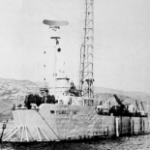 The Humble SM-1 drilling barge (204 × 34 × 13 ft) built and owned by Humble Oil and Refining Co. (now ExxonMobil) in 1957. The picture to the right shows the subsea equipment used to drill the wells. Note that it has no marine riser.
The Humble SM-1 drilling barge (204 × 34 × 13 ft) built and owned by Humble Oil and Refining Co. (now ExxonMobil) in 1957. The picture to the right shows the subsea equipment used to drill the wells. Note that it has no marine riser.
The Humble SM-1 drilled 65 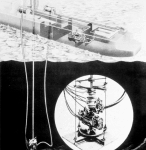 wells for a total cost of $11.74/ft, about double the cost of land drilling at the time, in an average water depth of 159 ft and with a maximum well depth of 5,000 ft. The unit averaged 8.93 days per well and drilled an average of 324 ft/D. Unfortunately, the unit sank in a storm in 1961 while on loan to another operator. At the insistence of insurance underwriters, the American Bureau of Shipping (ABS) wrote and implemented, in 1968, the first independent codes, guidelines, and regulations concerning the design, construction, and inspections of MODU hulls.
wells for a total cost of $11.74/ft, about double the cost of land drilling at the time, in an average water depth of 159 ft and with a maximum well depth of 5,000 ft. The unit averaged 8.93 days per well and drilled an average of 324 ft/D. Unfortunately, the unit sank in a storm in 1961 while on loan to another operator. At the insistence of insurance underwriters, the American Bureau of Shipping (ABS) wrote and implemented, in 1968, the first independent codes, guidelines, and regulations concerning the design, construction, and inspections of MODU hulls.
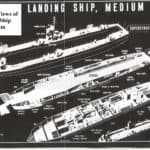 More info on Landing Ship Mediums (LSM’s) from Wikipedia
More info on Landing Ship Mediums (LSM’s) from Wikipedia
View underwater images of the SM1-multi-beam zoomed and hybrid—Thank you, Jonathan Hanks
video of the Humble SM1-courtesy of Ken Kollwitz
To read more about the SM1-Humble and learn more about wreck diving, please visit the California Wreck Divers (CWD) website.
The Gosford
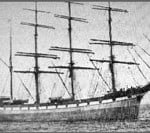 The Gosford was a four-masted cargo sailing ship. She was well built-in 1891 in Greenock, Scotland, and was 281’ long and 42’ wide. In 1893, the Gosford was carrying a load of coal, and while a long way offshore the coal had started to burn, not a good thing. The captain changed her course to the nearest land. The fire kept burning for 5 days as the crew kept trying to put it out, but with no luck.
The Gosford was a four-masted cargo sailing ship. She was well built-in 1891 in Greenock, Scotland, and was 281’ long and 42’ wide. In 1893, the Gosford was carrying a load of coal, and while a long way offshore the coal had started to burn, not a good thing. The captain changed her course to the nearest land. The fire kept burning for 5 days as the crew kept trying to put it out, but with no luck.
She was towed the last 35 miles to Coho, Anchorage where on November 24, 1893, she sank in  35’-40’ of water. She now sits in 35’-40’ of water on a sandy bottom with lots of fish and kelp growing all around her and is now an excellent artificial reef. There is still much to see of the Gosford after all the years that have gone by including lots of photo opportunities not only of the Gosford, but also all the marine life that calls her home, sometimes you can spot the wolf eels in a hole on the starboard bow. The Gosford makes for a perfect shallow dive after diving the SM-1 and she is only about 10 minutes away from the SM-1.
35’-40’ of water. She now sits in 35’-40’ of water on a sandy bottom with lots of fish and kelp growing all around her and is now an excellent artificial reef. There is still much to see of the Gosford after all the years that have gone by including lots of photo opportunities not only of the Gosford, but also all the marine life that calls her home, sometimes you can spot the wolf eels in a hole on the starboard bow. The Gosford makes for a perfect shallow dive after diving the SM-1 and she is only about 10 minutes away from the SM-1.
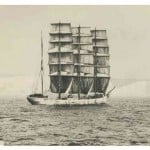 Here is a picture of the Gifford. She was the sister ship to the Gosford.
Here is a picture of the Gifford. She was the sister ship to the Gosford.
To read more about the Gosford and learn more about wreck diving, please visit the California Wreck Divers (CWD) website.